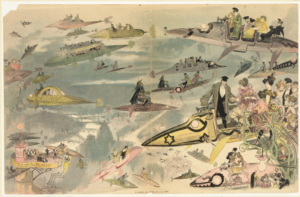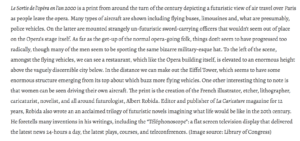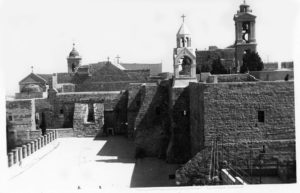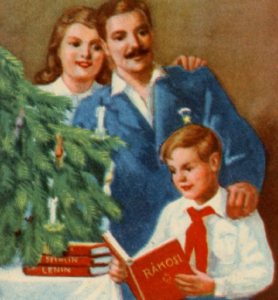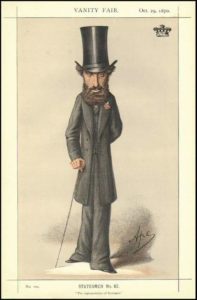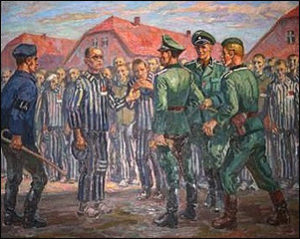Church of the Nativity
A large fortress-like church complex on Manger Square in Bethlehem centred on the site where Jesus was said to have been born.
As early as the second century local tradition claimed that the Nativity of Christ had taken place in a stable-cave, the location of which was sufficiently well-known that the Roman emperor Hadrian established a pagan grove there dedicated to Adonis in order to discourage Christian worship on the site. In the third century Origen and other visitors were still being directed to the spot. The theologian reported: “In Bethlehem the cave is pointed out where He was born, and the manger in the cave where He was wrapped in swaddling clothes, and the rumor is in those places and among foreigners of the Faith that indeed Jesus was born in this cave.”
The first Church of the Nativity was built over the cave by Saint Helena, mother of the emperor Constantine. This church was later damaged in an uprising and was rebuilt in the sixth century at the command of the Byzantine emperor Justinian. When the area was overrun by Persian invaders in 614 legend claims that the Church of the Nativity was spared because of depictions in a mosaic of Magi in Persian dress.
The cross-shaped Church of St Mary of the Nativity, 170 feet long and 80 feet wide, stands above the small grotto where a silver star marks the spot where Jesus was born; the inscription reads Hic De Virgine Maria Jesus Christus Natus Est — “Here Jesus Christ was Born of the Virgin Mary.” Nearby is a chapel where the manger stood in which the infant was placed. Surrounding the Church of the Nativity are other chapels and convents of the Catholic, Orthodox and Armenian churches; these three denominations share the administration of various parts of the complex. Quarrels between them in the nineteenth century took on dangerous overtones. The Russian government supported the Orthodox claims while the Catholics were backed by the French government; these hard feelings were one of the reasons for the outbreak of the Crimean War in the 1850s. In May 2002, Israeli Defence Force troops besieged the church when Palestinian activists took refuge inside it.
The photo above was taken in late 1944 by my father who was serving with the Royal Air Force in Palestine.
Iron Curtain Christmas
After World War II, the Communist governments which the Red Army had imposed on eastern Europe tried to come to terms with Christmas. The Communist state apparatus, with its monopoly of the news media, publishing houses, educational system and the police, attempted to muscle religion out of the winter holiday by moving festivities to New Year, renaming events, making December 25 and 26 work days and replacing any magical gift-bringer who had religious connections (e.g., Saint Nicholas or the Christ Child) with Grandfather Frost. In the German Democratic Republic Christmas angels were renamed “end-of-year winged figures.” There were even attempts to divert the holiday to Joseph Stalin’s birthday on December 21. In Hungary the festival was called the “Feast of Father Winter” or “Feast of the Fir Tree”; December 26, St. Stephen’s Day, a traditional part of the Christmas season, became “Constitution Day.” In Czechoslovakia 1952 President Antonín Zapotcky told children that the traditional gift-bringer Jezisek (baby Jesus) had grown up and turned into Deda Mráz (Grandfather Frost). In Yugoslavia, translators of foreign books removed references to Christmas and changed them to New Year or omitted them altogether. The Christmas carol scene in The Wind in the Willows, for example, was excised but references to the pagan god Pan were left in.
The lameness and artificiality of these efforts can be seen in this 1952 New York Times quote from the Czech Communist newspaper Rude Pravo:
Dado Moros (Russian term for Little Father Frost) will arrive in Prague Dec. 1. He brings young Czech Communists a message of greeting from the Soviet young pioneers and will tell Prague children about the happy life of young builders of communism in the Soviet Union. That’s why adults as well as children await his arrival with great excitement and joy.
The Paignton Pudding Disaster
In 1819 the English town of Paignton produced a 900 lb. Christmas pudding in honour of the anniversary of their town charter. Despite being boiled in a brewer’s furnace for four days it remained uncooked, with the inside still raw. The townsfolk attempted an even more massive pudding in 1859 as part of a celebration of the arrival of the railway. This time it was cooked to perfection; made of 500 lbs of flour, 190 lbs of bread, 400 lbs of raisins, 184 lbs of currants, 400 lbs of suet, 96 lbs of sugar, 320 lemons, 150 nutmegs and 360 quarts of milk. The Monster Pudding (as newspapers referred to it) was over 13’ feet in circumference and rested on a wagon pulled by 8 horses. It was meant to feed 850 poor of the parish as well as 300 railway labourers but, before that could happen, a crowd of 18,000 sight-seers, well-lubricated by the local cider, rushed the pudding, swept aside its police escort and demolished the dessert in scenes of riotous disorder.
As monstrous as the Paington Pudding was, it would have been dwarfed by that giant Christmas pudding of over 3 tons made in Aughton, Lancashire in 1992.
Animal crackers
Animal crackers were in the news recently when PETA (People for the Eating of Tasty Animals) took credit for convincing the manufacturers to change the cover illustration to one that did not depict the critters behind bars as in a circus or zoo. Readers may have been unaware of the connection between the treat and Christmas.
The National Biscuit Company in 1902 introduced “Barnum’s Animal Crackers” as a seasonal promotion. The box’s carrying string was designed for hanging on a Christmas tree at a time when candy and treats were still a typical decoration. Shirley Temple later celebrated the snack with the song “Animal Crackers in My Soup”.
Existential humour
More Bad Bulwer
She was like my ex-girlfriend Ashley, who’d stolen my car, broken my heart, murdered my father, robbed a bank, and set off a pipe bomb in Central Park – tall.
As the first shovelful of earth fell on her father’s coffin, Emily kneeled at the gravesite sobbing, overwrought by the sudden realization that, not only had she lost her only living relative, but she had somehow forgotten to set her DVR to record this week’s episode of “House of Cards,” an episode she had particularly wanted to see because of a rumored and breathlessly anticipated guest appearance by a nephew of Don Ho.
It was a dark and stormy night, and that translated into unchecked pandemonium among Los Angeles residents who hadn’t worn anything but open-toed shoes for five years, but tourist Alwyn Brewster was thankful for the scant traffic on Sunset Boulevard as he desperately accelerated his rental car through the tony neighborhoods, too preoccupied with the raging rivers of high-end, plastic patio-ware, which were making a break for the ocean, to notice a black Land Rover with diplomatic plates hot on his trail.
How Much Virtue?
How Much Virtue?
In 1850, Lord Palmerston the British government’s Foreign Secretary threatened war when Greece dealt unjustly with a pair of Queen Victoria’s subjects living abroad. The so-called “Don Pacifico Affair” led to a ringing assertion of the willingness of a nation to back claims by its passport holders no matter where. Palmerston felt that his country was “bound to afford protection to our fellow subjects abroad … as the Roman, in days of old, held himself free from indignity, when he could say “Civis Romanus sum”[I am a Roman citizen]; so also a British subject, in whatever land he may be, shall feel confident that the watchful eye and the strong arm of England, will protect him against injustice and wrong.”
On August 3, the government of Canada issued a statement of concern about the way that Saudi Arabia was treating a number of its citizens who had been agitating for further human rights inside the most Islamically conservative jurisdiction on the planet. Quite why our Foreign Affairs Minister felt moved to this action is a puzzle; activists of all sorts are repressed around the world on a daily basis, and any national interest of ours is of the most gossamer sort: one of those arrested was, apparently, the sister of an arrested blogger who is married to Ensaf Haidar, a woman with Canadian citizenship. Thus, Ottawa has imitated imperial Britain and taken its presumption one step further: now any far-flung sister-in-law of a Canadian may utter “Civis Canadiensis sum” and feel assured that our Dominion will act on her behalf.
Well, that escalated quickly. To everyone’s surprise Saudi Arabia did not take our righteous Twitter post in a spirit of chummy goodwill. It instantly declared our ambassador persona non grata, pulled their own emissary out of Canada, and ordered a legion of Saudi students and medical patients home from the land of the interfering infidel. Trade deals were threatened, Canadian grain was banned, Canadian assets were sold off, and an ominous warning emerged on a government-linked website that seemed to promise Canada the same treatment Saudi terrorists gave the World Trade Center on 9/11. Considering that Canada was hoping to soon consummate a lucrative sale of military hardware to the Saudis, it would be fair to say that our well-meaning intervention will cost our country billions of dollars.
However startled our government might have been by the Arabian response, Ottawa is not backing down. The Prime Minister has stated, “We will continue to stand up for Canadian values and universal values and human rights. Canada will always speak strongly and clearly in private and in public on questions of human rights.”
This surely prompts the question: how much virtue signalling can our country afford? What will be the price tag of Canadian demands that the USA and Mexico accept our views on gender equity in NAFTA? How far are we willing to go to make our position on Canadian values count, let us say, in a Chinese context? Are we willing to jeopardize our prosperity by interfering in Korean, Indian, Russian, or Brazilian affairs? This is an important issue on which it is possible for reasonable Canadians to disagree but we must have the debate, and soon.
Fortunately, there is a way in which we can profitably and morally stand up to trade and diplomatic bullying by one of the world’s most noxious nations, a country which still thinks that public crucifixion is a civilized response to crime. Canada should immediately cease to buy Saudi oil and replace it with western Canadian petroleum, transported securely by a pipeline. Quebec and Maritime consumers will thus be spared the sin of supporting an evil regime and see their fuel prices fall; the western Canadian economy will blossom; and Wahhabi fundamentalists will gnash their beards in impotent rage. That sounds like a win-win situation for us.
Bulwer-Lytton Prize Winners
“It was a dark and stormy night; the rain fell in torrents, except at occasional intervals, when it was checked by a violent gust of wind which swept up the streets (for it is in London that our scene lies), rattling along the housetops, and fiercely agitating the scanty flame of the lamps that struggled against the darkness.” So wrote Edward, Lord Bulwer-Lytton, the 19th-century English author of “The Last Days of Pompeii” and much other florid prose.
The University of San Diego conducts an annual Bulwer Lytton Fiction Contest for imitations of such rotten writing in various categories. We will reproduce a few of them here.
In 2011 the Grand Prize went to a Wisconsin professor for this pithy gem: “Cheryl’s mind turned like the vanes of a wind-powered turbine, chopping her sparrow-like thoughts into bloody pieces that fell onto a growing pile of forgotten memories”.
The Romance award that year: “As the dark and mysterious stranger approached, Angela bit her lip anxiously, hoping with every nerve, cell, and fiber of her being that this would be the one man who would understand – who would take her away from all this – and who would not just squeeze her boob and make a loud honking noise, as all the others had”.
The History winner: “Napoleon’s ship tossed and turned as the emperor, listening while his generals squabbled as they always did, splashed the tepid waters in his bathtub.”
Death of a Voluntary Martyr
1941
The German-Soviet conquest of Poland in the fall of 1939 was meant not just to occupy the country but to eradicate it. “All Poles,” said Hitler, “will disappear from the world.” Both the Nazi occupation forces and the Red Army immediately set about to destroy the Polish human infrastructure, murdering the officer class, the intellectuals and professionals or interning them in concentration camps. Clergy were a particular target: thousands of priests, monks, nuns, and seminarians were murdered. To the camp at Auschwitz in 1941 was sent Maximilian Maria Kolbe, a Franciscan friar.
Kolbe was born in 1894 when most of Poland was still part of the Russian empire. He joined the Franciscans at an early age and received an excellent education in Rome where he earned doctorates in both philosophy and theology. He became a priest in 1919 and returned to the newly-independent Polish Republic where he founded a monastery and operated a religious publishing house. In the 1930s he was sent on mission to Asia where he succeeded in opening a monastery in Nagasaki, Japan.
Kolbe was arrested briefly after the German invasion. He refused to be granted protected status which his German ancestry could have won him but instead operated a hospital and refuge in his monastery, sheltering many, including over a thousand Jews. He continued his printing operation whose anti-German publications resulted in his arrest by the Gestapo and his internment in Auschwitz.
At the end of July three prisoners from Kolbe’s block escaped and, as was the custom, ten other prisoners were selected to be executed in reprisal. One of those whose names were called out was Sergeant Franciszek Gajowniczek who cried out, “My wife! My children!” On hearing this, Kolbe stepped forward and told the SS captain: “I am a Catholic priest from Poland; I would like to take his place, because he has a wife and children.” He was granted his wish and with nine other condemned was sent to an underground cell where they were to be starved to death. According to the German guards, Kolbe’s behaviour was inspiring, leading his fellow prisoners in hymns and prayers and preserving their dignity until one by one they died, leaving only him alive. At this point the Germans decided they needed the cell and finished Kolbe off with a lethal injection.
Gajowniczek survived Auschwitz and another concentration camp, living out the war behind wire until the Red Army drove the Germans from Poland. He never ceased speaking of the man who had exchanged his own life for his. Soon miraculous healings were attributed to Kolbe’s heavenly intercession. In 1982 John Paul II, the first Polish pope, declared Kolbe a saint. He is considered to be the patron of drug addicts, political prisoners, families, journalists, and the pro-life movement.
